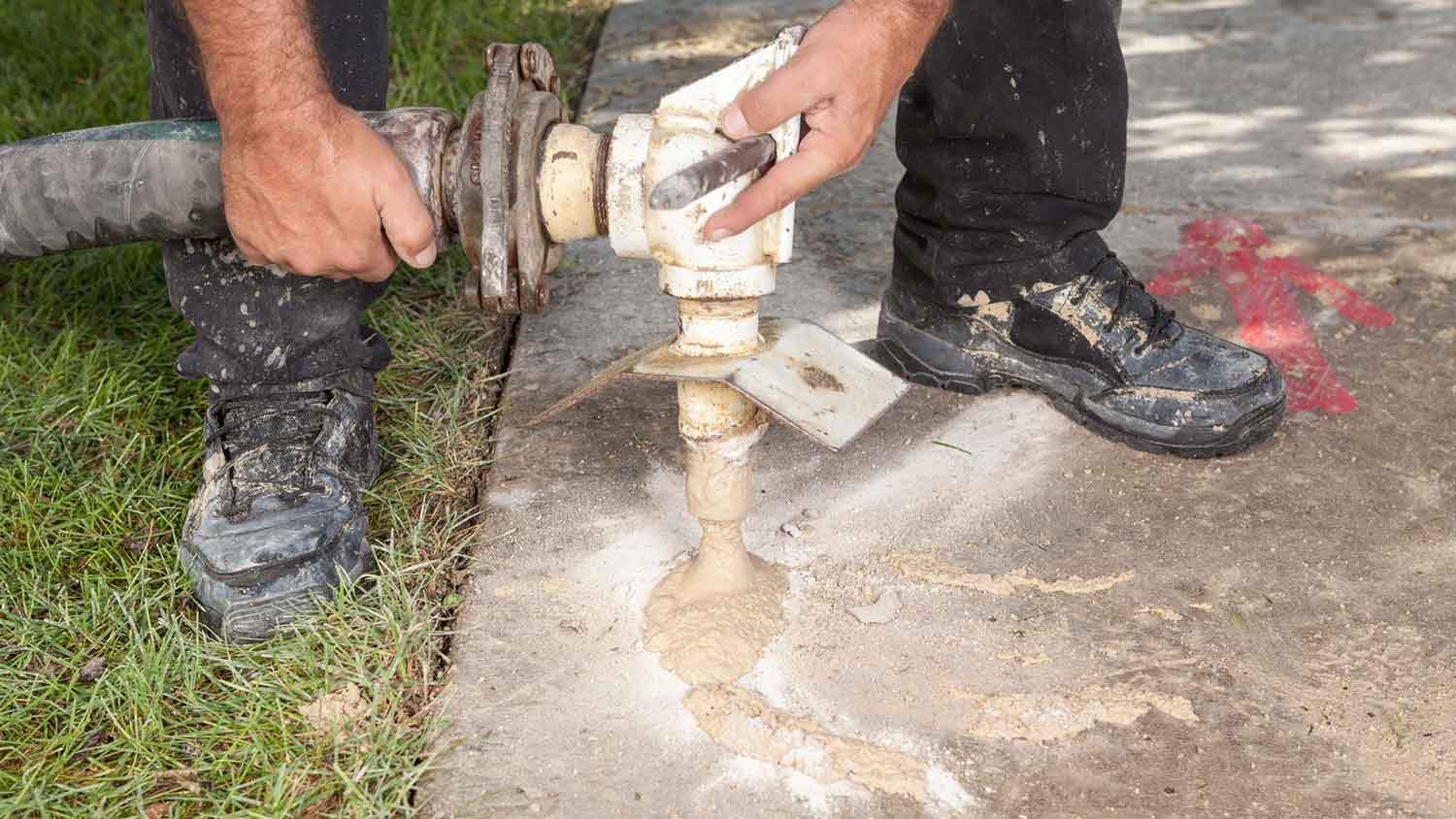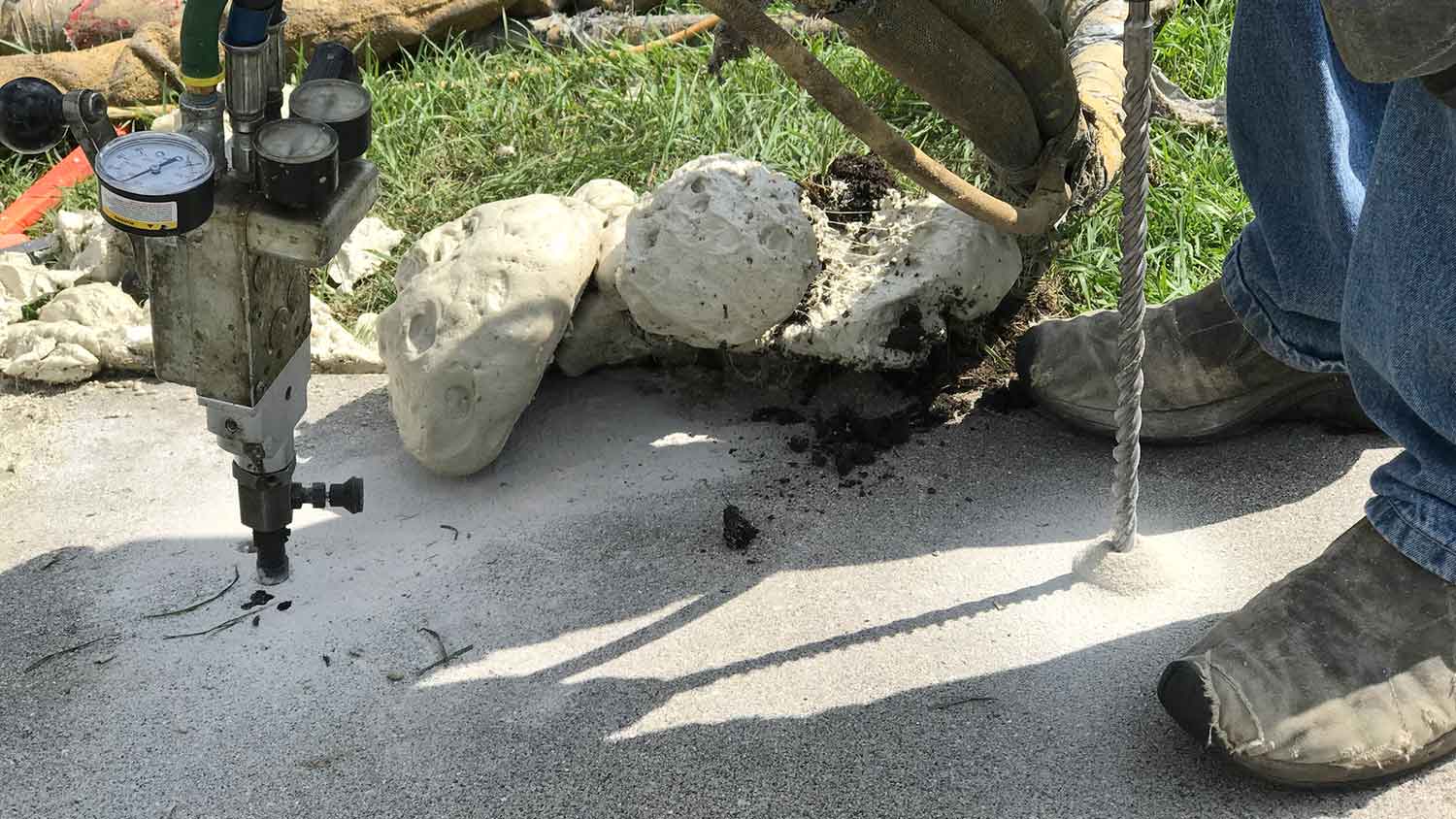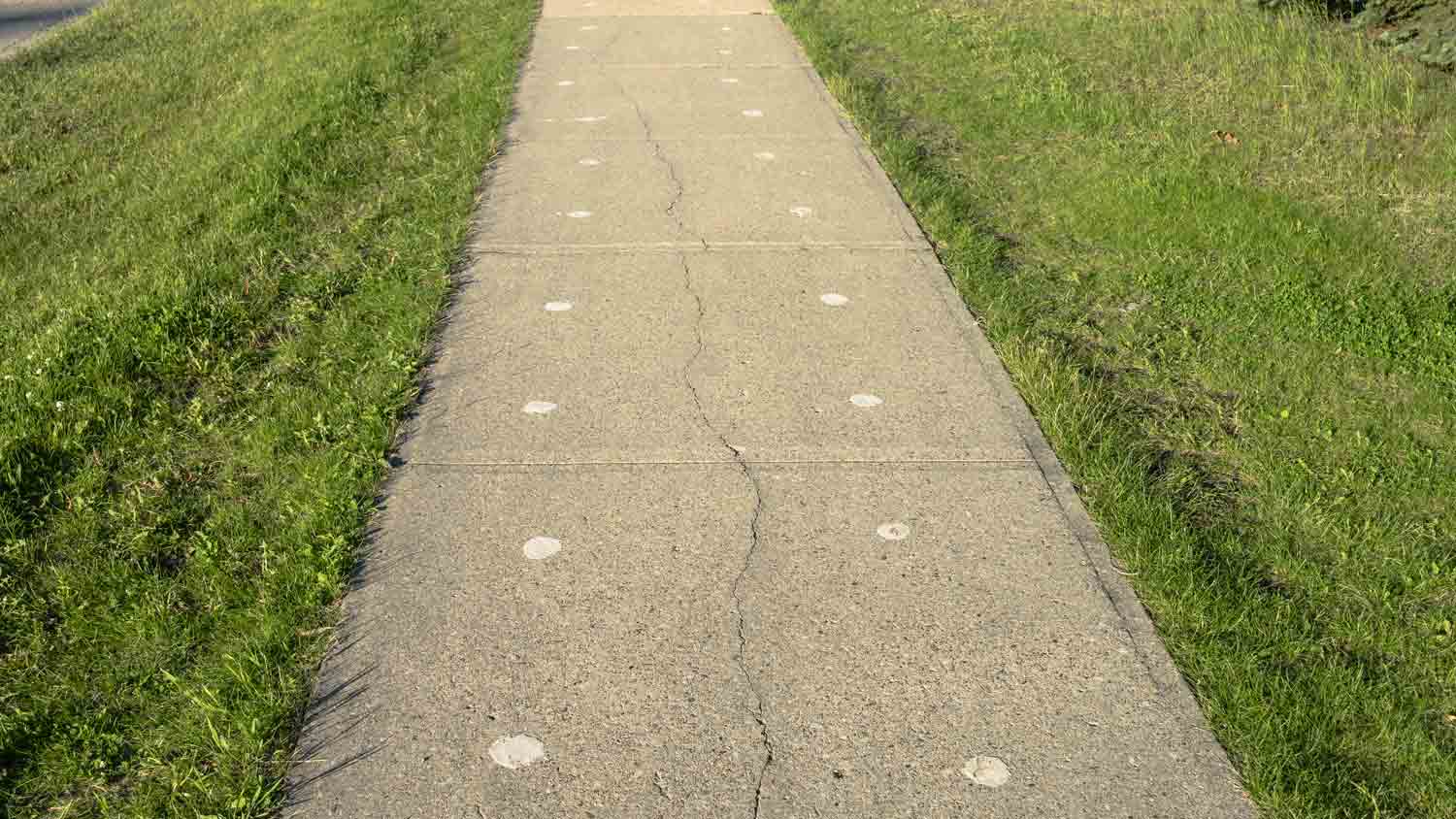
Don’t let sinking concrete capsize your budget. Learn about concrete leveling costs and the available methods to plan ahead for your project.
Stop tripping over uneven concrete with these repair methods


Mudjacking and polyjacking are methods used to level uneven concrete.
Both methods inject material under the concrete to lift and level it.
Mudjacking averages $3 to $6 per square foot.
Polyjacking averages $5 to $25 per square foot.
Polyjacking requires no curing time after installation.
Over time, the concrete slabs that make up your driveway, walkway, patio, or other home features may become uneven due to settling, shifting, and cracking. When you’re tired of tripping every time you walk up to your home, it’s time to fix the concrete. You have two repair methods to choose from: polyjacking and mudjacking. Learn the difference between the two and which one is right for your uneven concrete.
Both mudjacking and polyjacking are types of concrete leveling. They both involve injecting material under the concrete to lift and re-level it, making it a more cost-effective and less time-consuming fix than replacing the concrete slab entirely. Mudjacking is the older method and, as the name suggests, uses a mud-based slurry to raise concrete from underneath. Polyjacking is a newer method that injects polyurethane foam under the slab.

Mudjacking uses a slurry made of soil, clay, sand, limestone, and cement. The slurry may depend on the local climate, the use of the concrete slab, and other factors. The mudjacking process starts by drilling 2-inch holes at strategic intervals, then injecting the slurry until the slab is level. Once the slab is level, the holes are filled in and smoothed out.
| Pros | Cons |
|---|---|
| More cost-effective | Requires larger drill holes |
| Good for larger jobs | Takes longer to cure |
| Can withstand heavy weight | Can shift with erosion |
Best for:
Bigger jobs with more square footage
Driveways or other areas that will hold a lot of weight
Areas less prone to water intrusion
If you’re facing a big leveling project, mudjacking is a more cost-effective option, with its lower cost per square foot. It’s also great for areas like driveways that will hold a lot of weight.
The large holes that mudjacking requires can not only be unsightly but can cause smaller slabs to crack. In addition, a mudjacked slab takes 24 to 48 hours to fully cure before it can be used again, so any repaired areas will need to be avoided until the material has fully cured and can take weight again.

Polyjacking is similar to mudjacking but with a few key differences. Polyjacking injects high-density polyurethane foam under a concrete slab through drilled holes about the size of a dime. As the foam expands, it lifts the concrete slab until it is level, and then the injection holes are filled.
| Pros | Cons |
|---|---|
| Requires smaller injection holes | Less cost-effective |
| Little to no curing time | Foam may cure before filling all voids |
| Lightweight and strong | May overlift slab while expanding |
Best for:
Smaller slabs
Highly visible areas
Areas needing more precise repairs
Areas that need to be used immediately after repair
The advantages of polyjacking include much smaller injection holes than mudjacking, which makes polyjacking great for smaller slabs or areas that are more visible. Polyjacking also requires next to no curing time—once the foam has been injected, it only needs to cure for about 15 minutes, and then the concrete is ready to be used as usual.
The quick curing time and smaller injection holes do come at a price—polyjacking is significantly more expensive than other concrete leveling methods. Polyjacking also requires a fair amount of precision. The foam expands to fill in voids, so it’s possible to overlift a slab if too much material is injected before expansion. The fast setting time also requires quick work so that the foam doesn’t begin to cure before the job is done.
When it comes to pricing, the cost of mudjacking is usually much lower than polyjacking, mostly due to the cost of the injection materials. Mudjacking averages about $3 to $6 per square foot, while polyjacking costs between $5 and $25 per square foot.
After polyjacking, you can return to normal use of the concrete slab immediately, while mudjacking needs a day or two before it’s fully cured.
The foam used in polyjacking chemically reacts with the soil to stabilize the soil and concrete, and the material doesn’t degrade or erode. Mudjacking is more susceptible to settling, water erosion, and frost heaving.
Because polyjacking requires much smaller drill holes than mudjacking, there’s less chance of cracking the slab and requiring a full replacement.
If you’re looking to DIY your mudjacking or polyjacking, you’ll need specialized equipment like a hydraulic injection pump, so unless you already have the equipment on hand, it’s probably more cost-effective to hire a local concrete leveler to do the job.
Both types of concrete leveling are made to be long-lasting and will likely keep your concrete level without any need for regular maintenance. In some cases, however, mudjacking may need to be repeated in the future if erosion or settling occurs in the leveling material.
The right concrete repair method depends on your situation. To decide whether you’d be better off with mudjacking or polyjacking, consider the following:
Cost: For the most cost-effective option, mudjacking is the way to go, as its materials are easy to find and more affordable. Note that while polyjacking may be a bit more expensive than polyjacking, the higher price point may be worth it as it offers longer-lasting results.
Longevity: Mudjacking has the ability to lift and level concrete. However, it doesn’t deliver as long-term results as polyjacking. If you opt for mudjacking, you can expect the mixture to break down over time. Polyjacking, on the other hand, involves durable, moisture-resistant foam that ensures the concrete will remain lifted for a long period of time.
Aesthetics: Since the mudjacking process is messier and contains patched areas that might not match the original concrete perfectly, it’s not as attractive as polyjacking. Polyjacking is the way to go if you’re looking for a cleaner, more aesthetically pleasing look.
Soil Stability: While mudjacking can raise the surface of the concrete, it won’t compact or stabilize the surrounding soil. With its lightweight foam, polyjacking lifts the concrete and protects the surrounding soil without putting pressure on it.
Rachel Hoffman contributed to this piece.
From average costs to expert advice, get all the answers you need to get your job done.

Don’t let sinking concrete capsize your budget. Learn about concrete leveling costs and the available methods to plan ahead for your project.

Wondering about mudjacking costs? Discover prices, key cost factors, and tips to save on your concrete leveling project.
Learn about concrete leveling and how it can fix uneven surfaces, from sunken sidewalks to uneven driveways, and boost your home’s safety and curb appeal.

Leveling concrete slabs around your home is no small feat. Learn who to call to level your concrete slab and why they’re the right choice.

Mudjacking is an affordable fix for sunken or uneven concrete. Learn what mudjacking is and if it’s worth it for your driveway, sidewalk, or patio.

Sunken concrete can be a structural issue, but a professional can easily repair it. Ask these concrete injection leveling and mudjacking questions before you hire.